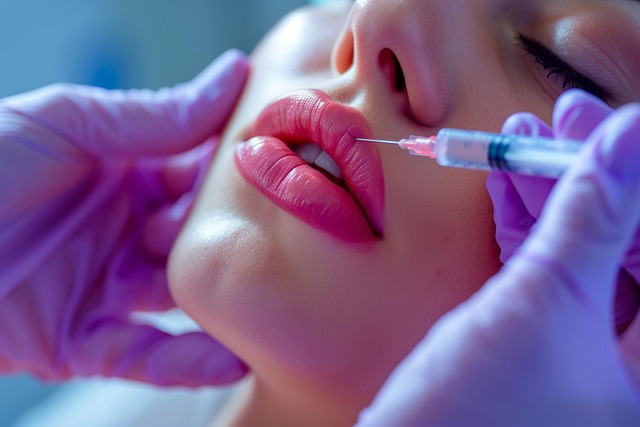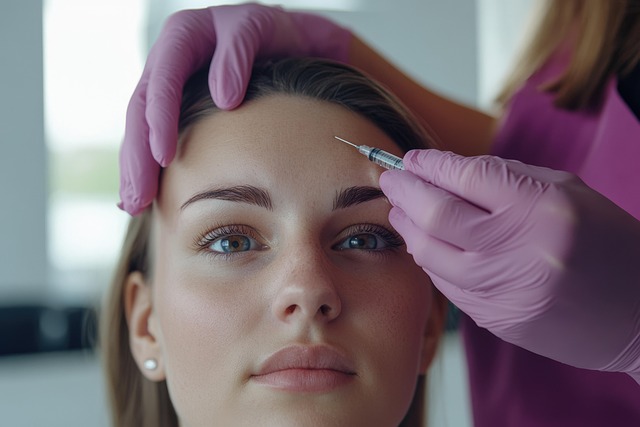Fine lines are natural aging indicators accelerated by sun exposure, smoking, and facial expressions. People use non-surgical treatments like Botox or dermal fillers for prevention and reduction. Botox, derived from bacteria, relaxes muscles to prevent dynamic wrinkles, while dermal fillers add volume using hyaluronic acid or collagen stimulators. Botox offers subtle, long-term results; dermal fillers provide immediate, longer-lasting solutions. Post-treatment care differs: rest, ice for Botox, and avoiding touch/strenuous activities for dermal fillers. The choice depends on personal preference, skin condition, desired outcomes, and long-term goals, emphasizing the unique benefits of each treatment.
“As we age, our skin’s elasticity decreases, leading to fine lines and wrinkles. This natural process can be accelerated by various factors, such as sun exposure and smoking. In this article, we explore two popular non-surgical treatments for fine line prevention: Botox and dermal fillers. We delve into their mechanisms, benefits, and differences, providing a comprehensive guide to help you understand when to consider these procedures. From addressing early signs of aging to maintaining youthful skin, discover the best approach for your skincare needs, considering both Botox vs. dermal fillers.”
Understanding Fine Lines and Their Causes

Fine lines, often the first visible signs of aging, are a natural part of the skin’s transformation over time. These delicate wrinkles can appear around the eyes, mouth, and forehead, giving rise to concerns about premature aging. Understanding their causes is key to preventing and managing them effectively. Environmental factors, such as sun exposure and smoking, play a significant role in developing fine lines and wrinkles. Additionally, expressions we make regularly, like squinting or frowning, can lead to temporary or permanent creases in the skin.
When it comes to addressing these subtle changes, Botox and dermal fillers are two popular non-surgical options. Botox, a protein derived from bacteria, is known for its ability to temporarily paralyze muscles, reducing dynamic wrinkling caused by facial expressions. On the other hand, dermal fillers enhance the skin’s volume by injecting hyaluronic acid or collagen stimulators, providing a more static solution for fine lines and enhancing overall facial contour.
Botox: A Natural Approach to Skin Rejuvenation

Botox, a natural substance derived from bacteria, has emerged as a popular and effective solution for fine line prevention and skin rejuvenation. Unlike dermal fillers that add volume to the skin, Botox works by relaxing specific muscle groups, reducing the appearance of wrinkles and fine lines. This non-invasive procedure offers a subtle yet noticeable improvement, making it a preferred choice for those seeking a more natural approach to skincare.
When considering Botox vs Dermal Fillers, it’s essential to understand their distinct mechanisms. While dermal fillers enhance skin texture by injecting hyaluronic acid or other substances, Botox focuses on muscle relaxation, providing a smoother and more youthful complexion. Both methods have their advantages, but Botox stands out for its ability to prevent the formation of new wrinkles, making it an excellent long-term solution for skincare enthusiasts.
Dermal Fillers: An Alternative for Deeper Wrinkles

When considering prevention and treatment for fine lines, many individuals often explore two popular options: Botox and dermal fillers. While both serve to enhance facial aesthetics, they target different aspects of wrinkle reduction. Botox is a neurotoxin that relaxes muscles, preventing the contraction that causes dynamic wrinkles, such as those around the eyes and mouth. On the other hand, dermal fillers are substances injected into the skin to add volume and lift, addressing deeper static wrinkles and providing immediate results.
For individuals with more pronounced or deeper wrinkles, dermal fillers may be the preferred choice. Unlike Botox, which is best for preventing and softening fine lines, dermal fillers can sculpt and redefine facial contours by adding substance where needed. This alternative offers a longer-lasting solution, making it ideal for those seeking a more significant and lasting transformation. However, the decision between Botox vs. dermal fillers ultimately depends on individual preferences, skin types, and the specific concerns one aims to address.
Comparison: Benefits of Botox vs Dermal Fillers

When it comes to preventing and reducing fine lines, two popular treatments that often come into comparison are Botox and dermal fillers. Both have their merits and can offer significant improvements in skin appearance, but they work in slightly different ways.
Botox is a neurotoxin that relaxes specific muscles, preventing them from contracting and causing wrinkles. It’s particularly effective for dynamic lines formed by facial expressions. On the other hand, dermal fillers are made of materials like hyaluronic acid or collagen, which are injected into the skin to add volume and plumpness, thereby smoothing out static lines and enhancing overall facial contour. While Botox offers a more temporary solution, typically lasting 3-6 months, dermal fillers can provide results that last for several years. The choice between them depends on an individual’s specific concerns, desired outcome, and long-term goals.
The Prevention Strategy: When to Consider Treatment

The prevention of fine lines and wrinkles is a popular anti-aging strategy, and Botox has emerged as a leading treatment option. Unlike dermal fillers, which add volume to the skin by injecting hyaluronic acid or other substances, Botox works by temporarily paralyzing muscles that cause dynamic wrinkle formation. This strategic approach targets specific areas of concern, such as frown lines, crow’s feet, and forehead wrinkles, when subtle treatments are desired.
Many individuals consider Botox treatment as a preventive measure well before significant wrinkles develop. By addressing muscle activity early on, it can delay the appearance of fine lines and provide a more youthful complexion. This is particularly appealing for those who want to maintain their natural look while minimizing the signs of aging. In contrast to dermal fillers, which offer immediate results but may require touch-ups over time, Botox provides a more gradual yet long-lasting effect, making it a preferred choice for those seeking subtle enhancements.
Post-Treatment Care and Maintenance

After your Botox or dermal filler treatment, proper post-care is essential for optimal results and to minimize any potential side effects. Unlike Botox, which relaxes muscles, dermal fillers enhance and restore volume. Therefore, post-treatment care differs slightly between these two popular cosmetic procedures.
For Botox recipients, it’s recommended to rest and avoid strenuous activities or exercise for a few hours after the procedure. Applying ice packs can help reduce any swelling or bruising. Staying hydrated and avoiding alcohol consumption for a day or two is also beneficial. In contrast, dermal filler patients might experience mild redness, swelling, or discomfort, which typically subsides within a few days. They should avoid touching or rubbing the treated area and refrain from strenuous activities until the product has fully settled into the skin (usually 2-3 days). Regular cleansing, hydration, and using sunscreen are crucial for maintaining healthy, glowing skin post-treatment.
